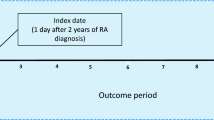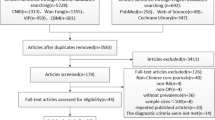Abstract
Summary
This is the first study that has found that rehabilitation services (RS) intervention, following the onset of rheumatoid arthritis (RA), may significantly reduce the risk of osteoporosis in RA patients. Those patients who received more than five sessions of RS had the greatest benefit for the prevention of osteoporosis.
Introduction
People with rheumatoid arthritis have increased risk of developing osteoporosis (OP). It remains unclear whether use of rehabilitation services can reduce the risk of developing OP. We conducted a longitudinal cohort study to compare the effect of RS on the risk of OP in Taiwanese individuals with RA.
Methods
A national health insurance database was used to identify 2693 newly diagnosed RA patients, 20–70 years old, between 1998 and 2007. Among them, 808 received RS after the onset of RA (RS users) and 1885 patients did not receive RS (non-RS users). All enrollees were followed until the end of 2012 to record incident cases of OP. A Cox proportional hazards regression model was used to compute adjusted hazard ratios (aHRs) for the relationship of use of RS with OP.
Results
During the 15-year follow-up, 358 RS users and 1238 non-RS users developed OP, corresponding to incidence rates of 87.24 and 129.27 per 1000 person-years, respectively. Use of RS was significantly associated with a lower risk of OP (aHR 0.62; 95% confidence interval [CI] = 0.56–0.71). Those who received more than five sessions of RS had the greatest benefit (aHR 0.47; 95% CI = 0.38–0.56).
Conclusions
The integration of RS into the clinical management of patients with RA may decrease their risk of developing OP.

Similar content being viewed by others
References
Sleath B, Chewning B, de Vellis BM, Weinberger M, de Vellis RF, Tudor G, Beard A (2008) Communication about depression during rheumatoid arthritis patient visits. Arthritis Rheum 59:186–191
Woolf AD, Pfleger B (2003) Burden of major musculoskeletal conditions. Bull World Health Organ 81:646–656
Lee SG, Park YE, Park SH, Kim TK, Choi HJ, Lee SJ, Kim SI, Lee SH, Kim GT, Lee JW, Lee JH, Baek SH (2012) Increased frequency of osteoporosis and BMD below the expected range for age among South Korean women with rheumatoid arthritis. Int J Rheum Dis 15:289–296. https://doi.org/10.1111/j.1756-185X.2012.01729.x
Staa TPV, Geusens P, Bijlsma JW et al (2006) Clinical assessment of the long-term risk of fracture in patients with rheumatoid arthritis. Arthritis Rheum 54:3104–3112. https://doi.org/10.1002/art.22117
Xue AL, Wu SY, Jiang L, Feng AM, Guo HF, Zhao P (2017) Bone fracture risk in patients with rheumatoid arthritis: a meta-analysis. Medicine (Baltimore) 96:e6983. https://doi.org/10.1097/MD.0000000000006983
Lin YC, Li YH, Chang CH, Hu CC, Chen DW, Hsieh PH, Lee MS, Ueng SWN, Chang Y (2015) Rheumatoid arthritis patients with hip fracture: a nationwide study. Osteoporos Int 26:811–817. https://doi.org/10.1007/s00198-014-2968-y
Kavuncu V, Evcik D (2004) Physiotherapy in rheumatoid arthritis. MedGenMed 6:3
Al-Qubaeissy KY, Fatoye FA, Goodwin PC, Yohannes AM (2013) The effectiveness of hydrotherapy in the management of rheumatoid arthritis: a systematic review. Musculoskeletal Care 11:3–18. https://doi.org/10.1002/msc.1028
Apti MD, Kasapçopur O, Mengi M et al (2014) Regular aerobic training combined with range of motion exercises in juvenile idiopathic arthritis. Biomed Res Int 2014:1–6. https://doi.org/10.1155/2014/748972
Elnaggar RK, Mohammed RA, Abdelhalim NM, Samhan AF (2015) A rehabilitation program recommendation for children with juvenile psoriatic arthritis. IJTRR 4:1–8
Li LC, Davis AM, Lineker SC, Coyte PC, Bombardier C (2006) Effectiveness of the primary therapist model for rheumatoid arthritis rehabilitation: a randomized controlled trial. Arthritis Rheum 55:42–52. https://doi.org/10.1002/art.21692
National Health Institute (2011) LHID 2000. http://nhird.nhri.org.tw/date_cohort.htm#3. Accessed 8 May 2017
Centers for Disease Control and Prevention (2014) Rheumatoid arthritis. http://www.cdc.gov/arthritis/basics/rheumatoid.htm. Accessed 19 Aug 2017
Lin HF, Wu YT, Tsauo JY (2012) Utilization of rehabilitation services for inpatient with cancer in Taiwan: a descriptive analysis from national health insurance database. BMC Health Serv Res 12:255. https://doi.org/10.1186/1472-6963-12-25
Shariff SZ, Cuerden MS, Jain AK, Garg AX (2008) The secret of immortal time bias in epidemiologic studies. J Am Soc Nephrol 19:841–843. https://doi.org/10.1681/ASN.2007121354
Liu CY, Hung YT, Chuang YL (2006) Incorporating development stratification of Taiwan townships into sampling design of large scale health interview survey. J Health Manag 4:1–22
Schwab P, Klein RF (2008) Nonpharmacological approaches to improve bone health and reduce osteoporosis. Incorporating development stratification of Taiwan townships into sampling design of large scale health interview survey. Curr Opin Rheumatol 20:213–217. https://doi.org/10.1097/BOR.0b013e3282f3cbd3
Bearne LM, Scott DL, Hurley MV (2002) Exercise can reverse quadriceps sensorimotor dysfunction that is associated with rheumatoid arthritis without exacerbating disease activity. Rheumatology (Oxford) 41:157–166
Turner CH, Robling AG (2005) Mechanisms by which exercise improves bone strength. J Bone Miner Metab 23(Suppl):16–22
Bolam KA, van Uffelen JGZ, Taaffe DR (2013) The effect of physical exercise on bone density in middle-aged and older men: a systematic review. Osteoporos Int 24:2749–2762. https://doi.org/10.1007/s00198-013-2346-1
Wu J, Wang X, Chiba H, Higuchi M, Nakatani T, Ezaki O, Cui H, Yamada K, Ishimi Y (2004) Combined intervention of soy isoflavone and moderate exercise prevents body fat elevation and bone loss in ovariectomized mice. Metabolism 53:942–948
Li L, Chen X, Lv S, Dong M, Zhang L, Tu J, Yang J, Zhang L, Song Y, Xu L, Zou J (2014) Influence of exercise on bone remodeling-related hormones and cytokines in ovariectomized rats: a model of postmenopausal osteoporosis. PLoS One 9:e112845. https://doi.org/10.1371/journal.pone.0112845
Thomson P, Jones J, Evans JM, Leslie SL (2012) Factors influencing the use of complementary and alternative medicine and whether patients inform their primary care physician. Complement Ther Med 20:45–53. https://doi.org/10.1016/j.ctim.2011.10.001
Manolagas SC, O’Brien CA, Almeida M (2013) The role of estrogen and androgen receptors in bone health and disease. Nat Rev Endocrinol 9:699–712. https://doi.org/10.1038/nrendo.2013.179
Demontiero O, Vidal C, Duque G (2012) Aging and bone loss: new insights for the clinician. Ther Adv Musculoskelet Dis 4:61–76. https://doi.org/10.1177/1759720X11430858
Feuerherm AJ, Borset M, Seidel C, Sundan A, Leistad L, Ostensen M, Faxvaag A (2001) Elevated levels of osteoprotegerin (OPG) and hepatocyte growth factor (HGF) in rheumatoid arthritis. Scand J Rheumatol 30:229–234
Acknowledgements
The study is based on data from the National Health Insurance Research Database, provided by the Bureau of National Health Insurance (Department of Health) and managed by National Health Research Institutes. The interpretation and conclusions contained herein do not represent those of the Bureau of National Health Insurance, Department of Health, or the National Health Research Institutes.
Funding
This research was supported by Dalin Tzuchi Hospital (Grant Number DTCRD105-I-14). Liu LC, Lu MC, Wang SY, and Livneh H contributed equally to this work.
Author information
Authors and Affiliations
Corresponding authors
Ethics declarations
This study was conducted in accordance with the Helsinki Declaration and was evaluated and approved by the local Institutional Review Board and Ethics Committee of Buddhist Dalin Tzu Chi Hospital, Taiwan (No. B10004021-2).
Conflicts of interest
None.
Rights and permissions
About this article
Cite this article
Liu, LC., Lu, MC., Wang, SY. et al. Association of use of rehabilitation services with development of osteoporosis among patients with rheumatoid arthritis: a nationwide population-based cohort study. Osteoporos Int 29, 1897–1903 (2018). https://doi.org/10.1007/s00198-018-4569-7
Received:
Accepted:
Published:
Issue Date:
DOI: https://doi.org/10.1007/s00198-018-4569-7




